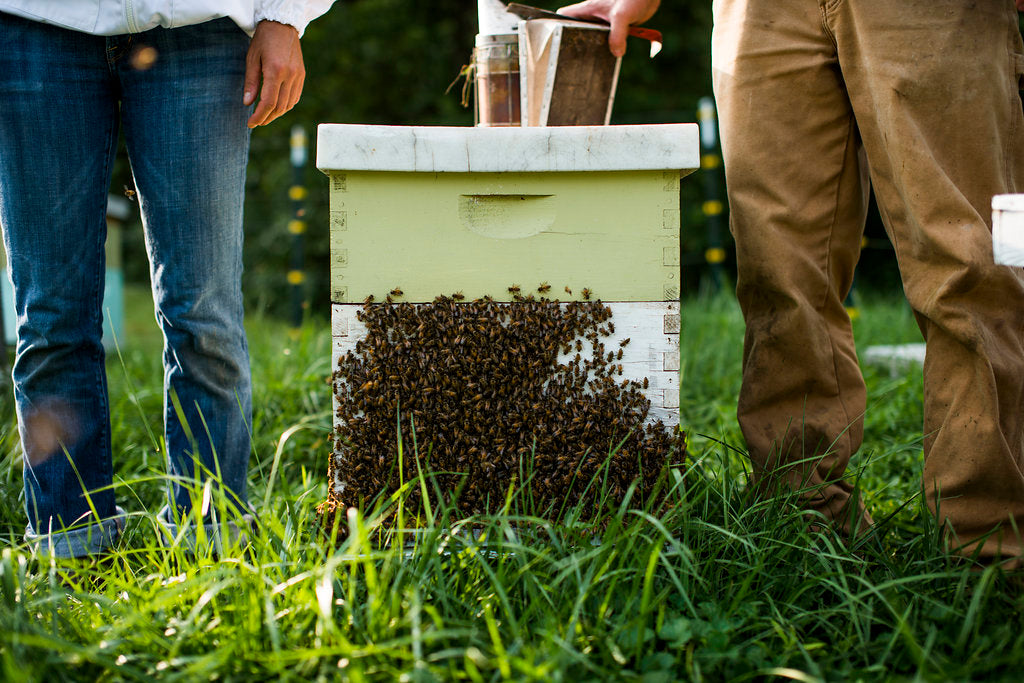If you’ve ever stood in a garden humming with bees, you know the joy of watching them work—tiny golden legs dusted with pollen, weaving bloom to bloom like they’ve got somewhere to be (because they do).
Here in the Southern Appalachian mountains of Western North Carolina, we’re lucky to have a diverse landscape full of native trees, shrubs, and wildflowers that honeybees and native pollinators love. But not all plants are created equal—some are nectar and pollen powerhouses, while others are all show and no forage.
If you're looking to plant a pollinator garden, support your local bees, or simply understand what’s feeding the hive, this guide highlights the best plants for honeybees in WNC—straight from the fields and forest edges we tend.
Top Trees for Honeybees in WNC
These trees are major nectar sources—feeding thousands of bees during peak bloom:
-
Tulip Poplar (Liriodendron tulipifera) – A top nectar source in early spring; our honey season often begins here.
-
Black Locust (Robinia pseudoacacia) – Fragrant, bee-loved blooms and light-colored honey.
-
Sourwood (Oxydendrum arboreum) – A prized mid-summer bloomer responsible for the unique flavor of Sourwood honey, native to the Southern Appalachians.
-
Maple (Acer rubrum & A. saccharinum) – Among the first to bloom in late winter, providing early pollen for brood-rearing.
-
Basswood (Tilia americana) – Also called American Linden, it’s rich in nectar and a midsummer bee favorite.
Native Shrubs That Feed the Hive
These bee-friendly native shrubs bloom during lean times and support consistent forage:
-
Sumac (Rhus glabra & R. copallinum) – Provides mid-summer nectar, often overlooked but very valuable.
-
Elderberry (Sambucus canadensis) – Loved by honeybees and native pollinators alike.
-
Blueberry (Vaccinium spp.) – Early pollen and nectar, and a delicious harvest for humans too!
-
Buttonbush (Cephalanthus occidentalis) – Distinctive globe-shaped flowers, buzzing with life in the summer heat.
-
Witch Hazel (Hamamelis virginiana) – A rare late-fall bloomer, offering one last nectar stop before winter.
Flowers & Perennials Honeybees Love
These pollinator-friendly perennials and herbs are ideal for gardens, borders, or wild patches. Many are native or well-adapted to WNC and bloom at different times throughout the growing season:
-
Bee Balm (Monarda fistulosa) – A vibrant native that lives up to its name.
-
Mountain Mint (Pycnanthemum spp.) – Hands-down one of the most bee-attracting plants we grow.
-
Goldenrod (Solidago spp.) – Crucial for late-season nectar when bees are prepping for winter.
-
Asters (Symphyotrichum spp.) – Another key fall bloomer rich in nectar and pollen.
-
Coneflower (Echinacea spp.) – Loved by pollinators and beautiful in the landscape.
-
Black-eyed Susan (Rudbeckia hirta) – A summer-long favorite with bright, cheerful blooms.
-
Purple Loosestrife (Lythrum salicaria) – Not native, but well-behaved in some settings and very attractive to bees.
-
Borage (Borago officinalis) – Edible, blue, and beloved by pollinators.
-
Creeping Thyme (Thymus serpyllum) – A bee-friendly ground cover with charming blooms.
-
Lavender (Lavandula spp.) – Fragrant and useful in pollinator gardens and kitchens alike.
-
Catnip (Nepeta spp.) – Bursts into bloom in early summer and bees go wild for it.
-
Chives (Allium schoenoprasum) – Their purple globe flowers are early-summer bee hotspots.
-
Salvia (Salvia spp.) – Long bloom time and high nectar yield makes this a must-have.
What to Avoid in a Bee Garden
These popular plants may look nice but don’t offer real value to bees:
-
Double-bloom hybrids – Often bred for appearance, not nectar or pollen.
-
Ornamental grasses – Typically wind-pollinated and not helpful to bees.
-
Invasive exotics – Especially Japanese honeysuckle and Bradford pear, which can crowd out native forage sources.
Every Jar of Honey Tells a Floral Story
Every jar of raw, local honey from Bee. honey+hive is flavored by these very blooms. When you plant for pollinators in Western North Carolina, you’re not just growing pretty flowers—you’re feeding the bees that support our food systems, ecosystems, and the next season’s honey.
It’s a small act, but a powerful one.
And the rewards? They’re sweet, golden, and humming with life.


